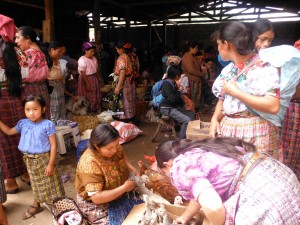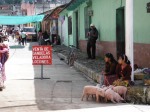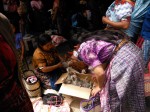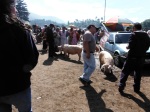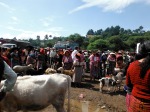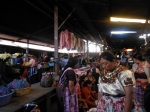“Want to take a little trip on thursday?”
Thursday, by no coincidence, was the day our school’s director would be away on personal business. I had chosen to remain with Juliza as my final Spanish teacher after filtering through a sort of foster care within the school. As a student, I am the sort of frustrating person who can’t be told what to do, and has to be tricked into a lesson. My first day with Juliza, I was too busy extending my vacation at Lake Atitlan to show up at class. Our second day, just after meeting, Juliza checked a text message, turned on a charmful smile and asked, “Want to take a little trip?” We spent the rest of the lesson gossiping while running errands at her son’s school. I like to think of our relationship as soul mates of indolence. We loved learning, we loved language, but we didn’t have patience for all the formality.
Our Thursday trip turned out to be our most excellently squandered lesson of all. Olintepeque, a village just outside the city of Xela, holds an exhaustive livestock market which was one of my most outlandish observances in Guatemala. As our chicken bus pulled up to Olintepeque–our companionable teacher-student truant pair in tow–I heard what sounded like children screaming just outside the window. We deboarded amidst a parade of marketeers taking their bounty home. An old woman walked near, 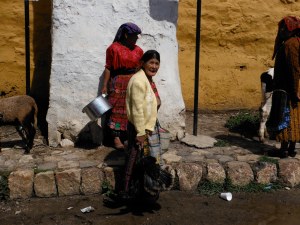 her arm immobile with the weight of a bundle of feathers. At closer glance, I saw the bundle blink, and then cluck. She had about four live chickens by the talons, as calmly as if she were pulling along a bundle of carrots. Even more disturbing, the chickens were also as casual as carrots. The four of us entered the market, passing a few stalls of attractive fabrics, and readying our wallets. However, past the inviting display, we walked right into a wall of animal frenzy encapsuled by manure stench. Tightening our ensemble, we nervously packed our wallets back into our bags. A pair of young girls marched from the assemblage, pulling along a resistant pack of piglets down the dirt road. I recognized the pigs’ squeals as the ‘children’s screams’ I had heard minutes earlier. The pigs didn’t walk a step; they locked their little legs into the dust, and the girls dragged them away, leaving panicked piglet dust trails behind. The four of us held our breath and entered further into the fray. Goats, sheep, horses, donkeys were all being led somewhere or other. Vendors called out their products to us as we passed. A small cow stepped in front of me and mooed. “These animals have already been bought,” explained my teacher, as she pointed out a barn shelter. Behind the barn, was an indoor market brimming with what was probably the entire town and all other surrounding villages. Nearly all vendors inside were women wearing traditional woven blouse and skirt; and this gave the indoor market a disparate aura from the outside lots. Swarms of color from the women’s clothes erased memories of muddy animals casting forlorn faces. Female chatter replaced mournful moos and piglet screams. Women and girls squatted over cardboard boxes filled with small grey bunnies, or chirping chicks in a netted sack.
her arm immobile with the weight of a bundle of feathers. At closer glance, I saw the bundle blink, and then cluck. She had about four live chickens by the talons, as calmly as if she were pulling along a bundle of carrots. Even more disturbing, the chickens were also as casual as carrots. The four of us entered the market, passing a few stalls of attractive fabrics, and readying our wallets. However, past the inviting display, we walked right into a wall of animal frenzy encapsuled by manure stench. Tightening our ensemble, we nervously packed our wallets back into our bags. A pair of young girls marched from the assemblage, pulling along a resistant pack of piglets down the dirt road. I recognized the pigs’ squeals as the ‘children’s screams’ I had heard minutes earlier. The pigs didn’t walk a step; they locked their little legs into the dust, and the girls dragged them away, leaving panicked piglet dust trails behind. The four of us held our breath and entered further into the fray. Goats, sheep, horses, donkeys were all being led somewhere or other. Vendors called out their products to us as we passed. A small cow stepped in front of me and mooed. “These animals have already been bought,” explained my teacher, as she pointed out a barn shelter. Behind the barn, was an indoor market brimming with what was probably the entire town and all other surrounding villages. Nearly all vendors inside were women wearing traditional woven blouse and skirt; and this gave the indoor market a disparate aura from the outside lots. Swarms of color from the women’s clothes erased memories of muddy animals casting forlorn faces. Female chatter replaced mournful moos and piglet screams. Women and girls squatted over cardboard boxes filled with small grey bunnies, or chirping chicks in a netted sack.
The market wasn’t our final destination that day. Our featured stop was a visit to the temple of San Pascual Bailon, which we were told held the skeleton of San Bailon himself. In Guatemala, San Bailon stands as one of many Catholic saints hybridized with Mayan beliefs. Not limited only to be an ephemeral guide, San Bailon materialized to this part of the earth in the form of a miniature human-like skeleton that was discovered buried in the surrounding hills during Spanish colonial rule. I never  completely grasped what sect of human misery San Bailon protected against or had special powers over, but I did understand that whatever a person might ask for, it was best accompanied by festive decorum and dancing (“bailon.”) Inside the temple, patrons stashed their live chicken bundles from the market to the sides, and found spaces on the center floor to place prayer candles—a different color for specific needs (money, love, children, health, etc.) One teenager in a backpack and hoodie approached the Mayan priest stationed at San Bailon’s altar with an armload of candles, one of each color. The priest blessed her with a smoking incense bundle, and then she walked back to light each candle on the floor, placing her prayers with concentration in the process. Other patrons were now approaching the Mayan priest and priestess, and speaking to the altar of San Bailon. The other student and I decided to check out this San Bailon for ourselves. We peaked at the glass case behind bountiful flower arrangements to see a tiny skull—no more than 2 inches wide—adorned with a tiny crown. What was likely the rest of the skeleton was dressed in regal clothes, and donned a cape. As sure as Juliza had promised, there stood the miniscule human-like skeleton representing San Pascual Bailon. We stood there, bemused and unsure of our reactions, caught between our skeptical sensibilities and the droll supernaturalism of the situation. Comparing my experience with San Simon (Maximon) in Zunil, I began to see a pattern of spirituality centered on, not the religious lore, nor the space of the temple, but rather on the humanesque representation of the spirit. Maximon, a life-size flamboyant store dummy, and San Bailon, a 12 inch carcass of God knows what. There is a tradition of tactility; face-to-face conversation with the saints on which these Guatemalans place their lives’ hopes. I know from personal contact, the shock of these off-set images of humanity–images that represent us, yet in aberration, stand for something more ethereal–was enough to fill me with some unearthly reverence.
completely grasped what sect of human misery San Bailon protected against or had special powers over, but I did understand that whatever a person might ask for, it was best accompanied by festive decorum and dancing (“bailon.”) Inside the temple, patrons stashed their live chicken bundles from the market to the sides, and found spaces on the center floor to place prayer candles—a different color for specific needs (money, love, children, health, etc.) One teenager in a backpack and hoodie approached the Mayan priest stationed at San Bailon’s altar with an armload of candles, one of each color. The priest blessed her with a smoking incense bundle, and then she walked back to light each candle on the floor, placing her prayers with concentration in the process. Other patrons were now approaching the Mayan priest and priestess, and speaking to the altar of San Bailon. The other student and I decided to check out this San Bailon for ourselves. We peaked at the glass case behind bountiful flower arrangements to see a tiny skull—no more than 2 inches wide—adorned with a tiny crown. What was likely the rest of the skeleton was dressed in regal clothes, and donned a cape. As sure as Juliza had promised, there stood the miniscule human-like skeleton representing San Pascual Bailon. We stood there, bemused and unsure of our reactions, caught between our skeptical sensibilities and the droll supernaturalism of the situation. Comparing my experience with San Simon (Maximon) in Zunil, I began to see a pattern of spirituality centered on, not the religious lore, nor the space of the temple, but rather on the humanesque representation of the spirit. Maximon, a life-size flamboyant store dummy, and San Bailon, a 12 inch carcass of God knows what. There is a tradition of tactility; face-to-face conversation with the saints on which these Guatemalans place their lives’ hopes. I know from personal contact, the shock of these off-set images of humanity–images that represent us, yet in aberration, stand for something more ethereal–was enough to fill me with some unearthly reverence.
When we all finally had our fill of the cluttered, eclectic crossing of life desires, livelihood, and livestock, we jumped on the bus back home. A woman next to me cradled a squirmy burlap sack, as blandly as if she were holding a baby. I knew it was best for me not to ask, and even better not to imagine.
